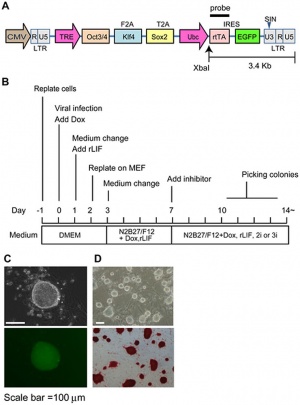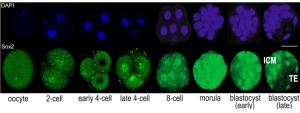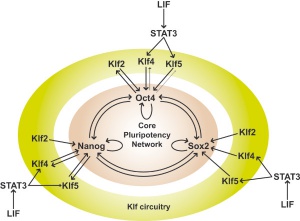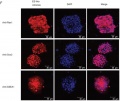Stem Cells - Induced
| Embryology - 27 Apr 2024 |
|---|
| Google Translate - select your language from the list shown below (this will open a new external page) |
|
العربية | català | 中文 | 中國傳統的 | français | Deutsche | עִברִית | हिंदी | bahasa Indonesia | italiano | 日本語 | 한국어 | မြန်မာ | Pilipino | Polskie | português | ਪੰਜਾਬੀ ਦੇ | Română | русский | Español | Swahili | Svensk | ไทย | Türkçe | اردو | ייִדיש | Tiếng Việt These external translations are automated and may not be accurate. (More? About Translations) |
Introduction
The term "induced stem cell" refers to the new methods of gene introduction and expression that generate stem cells from both embryo and adult tissues.
A useful guide (online PDF document) to stem cells was produced in a report by the National Institute of Health (NIH, USA, May 2000) Stem Cells: A Primer (note large size - 4.84 Mb) and more recently NIH has established a Stem Cell information page.
Some Recent Findings
|
| More recent papers |
|---|
|
This table allows an automated computer search of the external PubMed database using the listed "Search term" text link.
More? References | Discussion Page | Journal Searches | 2019 References | 2020 References Search term: Induced Stem Cells | OCT4 | SOX2 | | KLF4 | cMyc |
| Older papers |
|---|
| These papers originally appeared in the Some Recent Findings table, but as that list grew in length have now been shuffled down to this collapsible table.
See also the Discussion Page for other references listed by year and References on this current page.
|
Induced Pluripotent Stem Cell
2016 Interview with Shinya Yamanaka
<html5media width="480" height="360">https://www.youtube.com/embed/--o1aux_htA</html5media>
Development - 2016 Interview with Shinya Yamanaka (inducible Stem Cells)
| YouTube Links |
|---|
| Note - this may include both internal and external movie links.
|
Prof. Shinya Yamanaka ia a Nobel laureate and the developer of induced stem cells.

(iPS cell) A reprogrammed adult stem cell to form an embryonic stem cell, from which tissues or whole animals can develop. Can be generated by the expression of just four specific transcription factors.
Links: Nature Jul09 | ABC - Mice pups bred from adult stem cells
Yamanaka Factors
Yamanaka Factors[5][6] Are a set of 4 transcription factors when introduced into cells induces stem cell formation. These four transcription factors can be expressed from doxycycline (dox)-inducible lentiviral vectors.
OCT4
- Octamer-binding transcription factor 3/4
- Transcription factors containing the POU homeodomain
- Links: OMIM - OCT4
SOX2

- Sry-related HMG-Box gene 2.
- Sox2 is first expressed in very early (morula, blastocyst) development.
- Forms a trimeric transcription complex with OCT4.
- Gene targets - YES1, FGF4, UTF1 and ZFP206.
- Links: | Sox | OMIM - SOX2
KLF4
- Kruppel-like factor 4, zinc finger protein, transcription factor which acts as both an activator and repressor.
- alternative names: Epithelial zinc finger protein EZF or Gut-enriched krueppel-like factor
- Links: OMIM - KLF4
cMyc
- The MYC protooncogene encodes a DNA-binding factor that can activate and repress transcription.
- Ectopic expression of c-Myc can also cause tumorigenicity in offspring.
- More recently shown that Oct4 together with either Klf4 or c-Myc is sufficient to generate iPS cells from neural stem cells.[8]
- Tbx3 transcription factor significantly improves the quality of iPS cells.[9]
- Links: OMIM - MYC
Generation of human melanocytes from induced pluripotent stem cells
PLoS One. 2011 Jan 13;6(1):e16182.
Ohta S, Imaizumi Y, Okada Y, Akamatsu W, Kuwahara R, Ohyama M, Amagai M, Matsuzaki Y, Yamanaka S, Okano H, Kawakami Y. Source Division of Cellular Signaling, Institute for Advanced Medical Research, Keio University School of Medicine, Tokyo, Japan. Abstract Epidermal melanocytes play an important role in protecting the skin from UV rays, and their functional impairment results in pigment disorders. Additionally, melanomas are considered to arise from mutations that accumulate in melanocyte stem cells. The mechanisms underlying melanocyte differentiation and the defining characteristics of melanocyte stem cells in humans are, however, largely unknown. In the present study, we set out to generate melanocytes from human iPS cells in vitro, leading to a preliminary investigation of the mechanisms of human melanocyte differentiation. We generated iPS cell lines from human dermal fibroblasts using the Yamanaka factors (SOX2, OCT3/4, and KLF4, with or without c-MYC). These iPS cell lines were subsequently used to form embryoid bodies (EBs) and then differentiated into melanocytes via culture supplementation with Wnt3a, SCF, and ET-3. Seven weeks after inducing differentiation, pigmented cells expressing melanocyte markers such as MITF, tyrosinase, SILV, and TYRP1, were detected. Melanosomes were identified in these pigmented cells by electron microscopy, and global gene expression profiling of the pigmented cells showed a high similarity to that of human primary foreskin-derived melanocytes, suggesting the successful generation of melanocytes from iPS cells. This in vitro differentiation system should prove useful for understanding human melanocyte biology and revealing the mechanism of various pigment cell disorders, including melanoma.
Thomson Factors
OCT4
- Links: OMIM - OCT4
SOX2
- Links: OMIM - SOX2
NANOG
- Links: Nanog | OMIM - NANOG
LIN28
- Links:
Target Genes
Oct4, Nanog, and Sox2 target genes
References
- ↑ Li L, Li Y, Sottas C, Culty M, Fan J, Hu Y, Cheung G, Chemes HE & Papadopoulos V. (2019). Directing differentiation of human induced pluripotent stem cells toward androgen-producing Leydig cells rather than adrenal cells. Proc. Natl. Acad. Sci. U.S.A. , 116, 23274-23283. PMID: 31591190 DOI.
- ↑ Ben-David U & Benvenisty N. (2011). The tumorigenicity of human embryonic and induced pluripotent stem cells. Nat. Rev. Cancer , 11, 268-77. PMID: 21390058 DOI.
- ↑ Zhao XY, Li W, Lv Z, Liu L, Tong M, Hai T, Hao J, Guo CL, Ma QW, Wang L, Zeng F & Zhou Q. (2009). iPS cells produce viable mice through tetraploid complementation. Nature , 461, 86-90. PMID: 19672241 DOI.
- ↑ Hamanaka S, Yamaguchi T, Kobayashi T, Kato-Itoh M, Yamazaki S, Sato H, Umino A, Wakiyama Y, Arai M, Sanbo M, Hirabayashi M & Nakauchi H. (2011). Generation of germline-competent rat induced pluripotent stem cells. PLoS ONE , 6, e22008. PMID: 21789202 DOI.
- ↑ Takahashi K & Yamanaka S. (2006). Induction of pluripotent stem cells from mouse embryonic and adult fibroblast cultures by defined factors. Cell , 126, 663-76. PMID: 16904174 DOI.
- ↑ Takahashi K, Tanabe K, Ohnuki M, Narita M, Ichisaka T, Tomoda K & Yamanaka S. (2007). Induction of pluripotent stem cells from adult human fibroblasts by defined factors. Cell , 131, 861-72. PMID: 18035408 DOI.
- ↑ Keramari M, Razavi J, Ingman KA, Patsch C, Edenhofer F, Ward CM & Kimber SJ. (2010). Sox2 is essential for formation of trophectoderm in the preimplantation embryo. PLoS ONE , 5, e13952. PMID: 21103067 DOI.
- ↑ Kim JB, Zaehres H, Wu G, Gentile L, Ko K, Sebastiano V, Araúzo-Bravo MJ, Ruau D, Han DW, Zenke M & Schöler HR. (2008). Pluripotent stem cells induced from adult neural stem cells by reprogramming with two factors. Nature , 454, 646-50. PMID: 18594515 DOI.
- ↑ Han J, Yuan P, Yang H, Zhang J, Soh BS, Li P, Lim SL, Cao S, Tay J, Orlov YL, Lufkin T, Ng HH, Tam WL & Lim B. (2010). Tbx3 improves the germ-line competency of induced pluripotent stem cells. Nature , 463, 1096-100. PMID: 20139965 DOI.
- ↑ Ohta S, Imaizumi Y, Okada Y, Akamatsu W, Kuwahara R, Ohyama M, Amagai M, Matsuzaki Y, Yamanaka S, Okano H & Kawakami Y. (2011). Generation of human melanocytes from induced pluripotent stem cells. PLoS ONE , 6, e16182. PMID: 21249204 DOI.
Reviews
Moraleda JM, Blanquer M, Bleda P, Iniesta P, Ruiz F, Bonilla S, Cabanes C, Tabares L & Martinez S. (2006). Adult stem cell therapy: dream or reality?. Transpl. Immunol. , 17, 74-7. PMID: 17157222 DOI.
Serafini M & Verfaillie CM. (2006). Pluripotency in adult stem cells: state of the art. Semin. Reprod. Med. , 24, 379-88. PMID: 17123233 DOI.
Pessina A & Gribaldo L. (2006). The key role of adult stem cells: therapeutic perspectives. Curr Med Res Opin , 22, 2287-300. PMID: 17076989 DOI.
Articles
- Journal of Visualized Experiments - Generating iPS Cells from MEFS through Forced Expression of Sox-2, Oct-4, c-Myc, and Klf4
Hanna J, Saha K, Pando B, van Zon J, Lengner CJ, Creyghton MP, van Oudenaarden A & Jaenisch R. (2009). Direct cell reprogramming is a stochastic process amenable to acceleration. Nature , 462, 595-601. PMID: 19898493 DOI.
Ross JJ & Verfaillie CM. (2008). Evaluation of neural plasticity in adult stem cells. Philos. Trans. R. Soc. Lond., B, Biol. Sci. , 363, 199-205. PMID: 17282993 DOI.
Prentice DA & Tarne G. (2007). Treating diseases with adult stem cells. Science , 315, 328. PMID: 17234930 DOI.
Search PubMed
Search PubMed: Feb 2007 "adult stem cells" 811 reference articles of which 367 were reviews.
Search PubMed Now: adult stem cells | induced pluripotent stem cell |
Additional Images
External Links
External Links Notice - The dynamic nature of the internet may mean that some of these listed links may no longer function. If the link no longer works search the web with the link text or name. Links to any external commercial sites are provided for information purposes only and should never be considered an endorsement. UNSW Embryology is provided as an educational resource with no clinical information or commercial affiliation.
- Center for iPS Cell Research and Application, Kyoto University Generation of Human induced Pluripotent Stem Cells PDF
- Journal of Visualized Experiments - Generating iPS Cells from MEFS through Forced Expression of Sox-2, Oct-4, c-Myc, and Klf4
- NIH Stem Cells - [http://stemcells.nih.gov/staticresources/info/scireport/PDFs/Chapter_10.pdf
Glossary Links
- Glossary: A | B | C | D | E | F | G | H | I | J | K | L | M | N | O | P | Q | R | S | T | U | V | W | X | Y | Z | Numbers | Symbols | Term Link
Cite this page: Hill, M.A. (2024, April 27) Embryology Stem Cells - Induced. Retrieved from https://embryology.med.unsw.edu.au/embryology/index.php/Stem_Cells_-_Induced
- © Dr Mark Hill 2024, UNSW Embryology ISBN: 978 0 7334 2609 4 - UNSW CRICOS Provider Code No. 00098G







